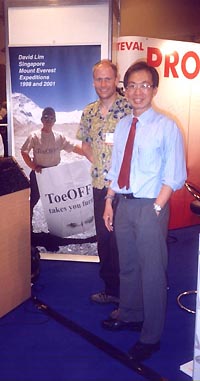Wed 7 Jan 2004, Nairobi
Africa! Here at last in sunny Nairobi. Temperatures at 22 degrees C make it very mild even when thesun is shining. We’re picking up the rest of the team at 8pm and then heading for a big pow-wow and eats at the famous Carnivore restaurant where three items are on the menu: Meat, meat and meat. Tomorrow , we leave for the Tanzania border and Moshi, our base of operations for Kilimanjaro. En route, we’ll stop at lunchtime at the Upendo Leprosy Centre to see the place and meet the good people that we have been in contact with for 2 years
Word from our operators say a lot of rain has been about ( unseasonal ). That means a good dusting of snow on the mountain – which should make it less icy on our desired route – a good sign
Crocodile steak anyone?
Checking out,
David
Friday, 9 Jan 2004, Machame Camp, 3,000m
 We are on the trail! Our walk began at Machame Gate, a short way from Machame Village, a small community at 1,500m. Reached 3,000m after trudging up the Machame Route for about 5 hours through mountain rainforests. Tomorrow we will make our way through scrubland to Shira Camp where we will rest and acclimatise. Tonight, we camp here at Machame Camp, which is on the Shira Plateau. The route here was nice, the plants and cool air reminds me of the route up Mt Kinabalu in Sabah. We are all warming up our muscles and gearing up for the climb ahead. All are well !
We are on the trail! Our walk began at Machame Gate, a short way from Machame Village, a small community at 1,500m. Reached 3,000m after trudging up the Machame Route for about 5 hours through mountain rainforests. Tomorrow we will make our way through scrubland to Shira Camp where we will rest and acclimatise. Tonight, we camp here at Machame Camp, which is on the Shira Plateau. The route here was nice, the plants and cool air reminds me of the route up Mt Kinabalu in Sabah. We are all warming up our muscles and gearing up for the climb ahead. All are well !
David
11 Jan 2004, Shira Plateau, 3,800m
 We spent the day hiking and acclimatising. We did a 4 hour hike today. Tomorrow, we will be climbing up to Lava Tower which is at 4,600m. The weather here is challenging. Mornings begin with clear skies, great climbing weather. But for the afternoons, we see clouds moving in and everything gets moist and damp.
We spent the day hiking and acclimatising. We did a 4 hour hike today. Tomorrow, we will be climbing up to Lava Tower which is at 4,600m. The weather here is challenging. Mornings begin with clear skies, great climbing weather. But for the afternoons, we see clouds moving in and everything gets moist and damp.
The last few days have been interesting for all of us. We are getting to know each other’s strengths and weaknesses. Each of us have different impairments and this has been a learning experience. Each of us struggle against our own limitations everyday. And in spite of it, all of us are in great shape both physically and mentally. (BTW : We have not run out of our stock of bad jokes yet!)
David
12 Jan 2004, Lava Tower Camp, 4600m
Reached Lava Tower after 4 hours of hiking. It’s lunch time here, about 1:30pm Kilimanjaro time. Nothing much to eat except trail food. Where is that impala steak when you need one.
We are all in good shape, a bit of sore muscles and a few blisters. We are in good health. Jamie, says to tell all that he is fine and doing well. Pete, wants meat too.
There are some Austrians here at Lava Tower Camp too, they seem impressed by our trekking skills. They ain’t seen nothing yet… 🙂 The views here are great, offering us a good look at the glacier route that we planned to take. Tomorrow, we will rest and acclimatise at this altitude.
David
13 Jan 2004, Moir Hut, 4,200m
We woke up to a wet and cloudy day today, it rain sporadically during the rest of the day. We ended up rather moist and damp, and a bit gamey. Spent a rather uncomfortable night at Lava Tower Camp. We didn’t sleep too well so we decided to move down today to about 4,200m and set up accommodations for the night. At a lower altitude, we hope that we will get our required beauty sleep… 🙂 We are now at Moir Hut, a small campsite midway between Lava Tower Camp and Shira Camp. This trail requires some climbing over scree slopes and boulders. A bit tiring.
Tomorrow, we will begin the tough part of the climb. We will make our way to the base of Credner or Penck glaciers. Then, we plan to spend some time acclimatising and planning our next move. We anticipate steep climbing over snow and rocks, it will challenge every one of us. On the 16th, we will attempt the glacier route and if everything goes well, 17th Jan will be summit day.
We are all feeling a bit tired today, because of a lack of sleep last night. Other than that, we are all OK. All our limbs are holding up to the punishment. We look forward to some hard climbing tomorrow.
David
15 Jan 2004, 3800m Shira Camp
It was a bit eventful yesterday. Paul developed a mild case of altitude sickness. So we moved down further to Shira Camp at 3,800m for the night. He seems better this morning.
Yesterday, Pete and I, went for a hike up to Credner Glacier from Shira Camp after moving with the rest for the team down to Shira Camp. We climbed up about 500 vertical meters to about 4,610m, reaching the edge of the glacier, before it started raining and snowing. Visibility was limited as the clouds came down. Looking at the wicked terrain there, our conclusion was that we have to take the Western Breach route instead of the Credner Glacier. The alternative plan.
It just stopped raining, and it looks like a fine morning today. Our next move will be to move up to Lava Tower Camp again before making a summit attempt. Everyone have had a good rest last night. We still think a steak would be good for dinner…. 🙂
David
17 Jan 2004, morning, 4,600m, Lava Tower Camp
We left Shira Camp and made our way up to Lava Tower Camp yesterday. Some other climbers went up to Credner Glacier yesterday for a look, and I think they found the going there tough too.
Spent the night here. It started raining and snowing yesterday and it kept on going for about 15 hours. Last night, you would see us huddled around feeling rather morose, damp and cold. It was a cold night and because of the rain and snow, much of our stuff’s frozen this morning. Lava Tower Camp is now covered with about 3 inches of snow. The hill in front of us looks covered with more snow, and we might be ploughing through as much as 12 inches of snow higher up.
The sun’s up this morning and around camp, you will see us hanging our delicates up to dry in the bright sun :). Morale’s up too, a change from last night’s low.
Our plan now is to get some of our stuff dry, make our way up to Arrow Glacier which is about 200 vertical meters above us. This should be a 2 hours hike. Rest at Arrow Glacier and we will begin our summit attempt at about midnight tonight.
David
18 Jan 2004, 3pm, 5,895m Kibo
All of us reached the summit, it is now 3pm. It has been a long hard climb up but it is worth it. The view is fantastic, breathtaking. We are the only team on the summit. Standing on the top of Kilimanjaro has been a challenge, the scree and snow gave us a bit of difficulty. The sun’s still shinning and it is a beautiful day. We now face the prospect of a long descent down the mountain. Our plan is to descent and camp at Karanga Hut.
David
19 Jan 2004, Karanga Hut
From the summit, Kibo, we descended 1,400m down to camp and rest. We took a different route, going down the other side of the mountain. We started our descend at about 3pm and we stopped just before midnight, making it a 23 hour day, from ascent to descent. In between, we chewed a few cereal bars. We were looking very hungry when we finally stopped. Tired… and dehydrated. Did the necessary, boil water, drink, boil more water, drink some more and eat some stuff before crawling to rest in the tent. All of us felt great from the climb. Tired but good.
Our next move will be to leave the mountain via Mweka Gate and then off to Moshi town for a good wash and fresh meat!! slurp.
David
20 Jan 2004, 2pm (Singapore), 3,000m Mweka Camp
It’s morning here. We are packing up and moving down to Mweka Gate and then catch a ride to Moshi town. Long last, a hot bath and food. We hope to reach Moshi by tonight. Lots of aching muscles but we are happy. The local press seems taken by our expedition. I take it that they have never seen a more motley group of disabled climbers before.
David
Wed Jan 21, 2004, Media Release
The Voltaren Kilimanjaro Challenge succeeded in climbing to Africa’s summit, Mt Kilimanjaro on Jan 18th scoring a possible first in placing an international team of four disabled climbers on top.
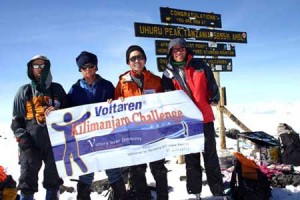
A variety of setbacks from unseasonal bad weather to illness forced the team to abandon its original plan to climb the straightforward but remote Credner Glacier. Instead, the team focused on the Western Breach route, a more approachable route but one with a steep face; laced with rock steps and cliffs. The preceding week’s bad weather had plastered Kilimanjaro with a thick coating of snow; giving the peak an unusual icing. No other teams were on the route that day.
Leaving their 4800m camp at 0100hrs , they climbed through most of the night on the 18th; reaching the summit crater rim ( 5700m ) between 1030 – 1100hrs. From here, Uhuru ( the main summit of Kilimanjaro ) was reached at around 1500hrs in good conditions. The team helped each other where personal physical impairments caused some difficulties at the technical sections.
Messrs Pete Steane, Jamie Andrew, David Lim and Paul Pritchard descended from the summit at 1600hrs and began a gruelling seven-hour descend into the darkness to their Karanga campsite on the southeastern side of the mountain. The whole summit day took 23 hours. Dehydrated and tired from the climb, the team pulled into the campsite at about 0030 hrs, Jan 19th.
The team have returned to their respective countries, with Messrs Paul Pritchard and Pete Steane transiting in Singapore on Jan 25th prior to their return to Australia.
The climb has been covered extensively in the world media including:
BBC Worldservice (Jan 9)
CNN (Jan 13, Jan 19)
The Times ( UK ) Jan 12
The Scotsman ( UK ) Jan 23
The Straits Times ( Singapore ) Jan 7, 24
Streats ( Singapore ) Jan 6
Channelnewsasia Jan 23
Arusha Times ( Tanzania ) Jan 17-23
The Daily Nation ( Kenya ) Jan 23
EverestNews.com
The team thanks it supporters:
Voltaren Emulgel [ Novartis OTC ( Asia Pacific ) ],
and Reuters Foundation;
With support from:
Marmot,
DMM,
Canon,
Emirates Airlines,
Mountain Designs,
Black Diamond Equipment,
Nike Timing.
Sandisk and
Ad Idem Productions

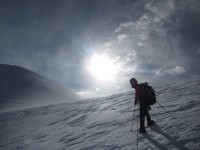






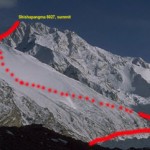







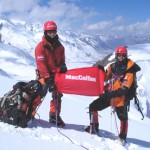

















 Everything they produce is suppported by their lifetime warranty “Marmot For Life”.
Everything they produce is suppported by their lifetime warranty “Marmot For Life”.






 Pete Steane – Australia. Hails from the island of Tasmania. In 1982 he sustained a rock-climbing accident where a piece of climbing equipment pierced his spine. He now lives with permanent nerve damage and walks and climbs with the help of two leg braces. A teached by profession, Pete has climbed on the rock faces of Yosemite National Park ( USA ) and in the New Zealand Alps.
Pete Steane – Australia. Hails from the island of Tasmania. In 1982 he sustained a rock-climbing accident where a piece of climbing equipment pierced his spine. He now lives with permanent nerve damage and walks and climbs with the help of two leg braces. A teached by profession, Pete has climbed on the rock faces of Yosemite National Park ( USA ) and in the New Zealand Alps.

 The Kilimanjaro film team comprises the director/videographer pair of Richard Heap (above) and Benedict Bevan-Pritchard (below)
The Kilimanjaro film team comprises the director/videographer pair of Richard Heap (above) and Benedict Bevan-Pritchard (below)
